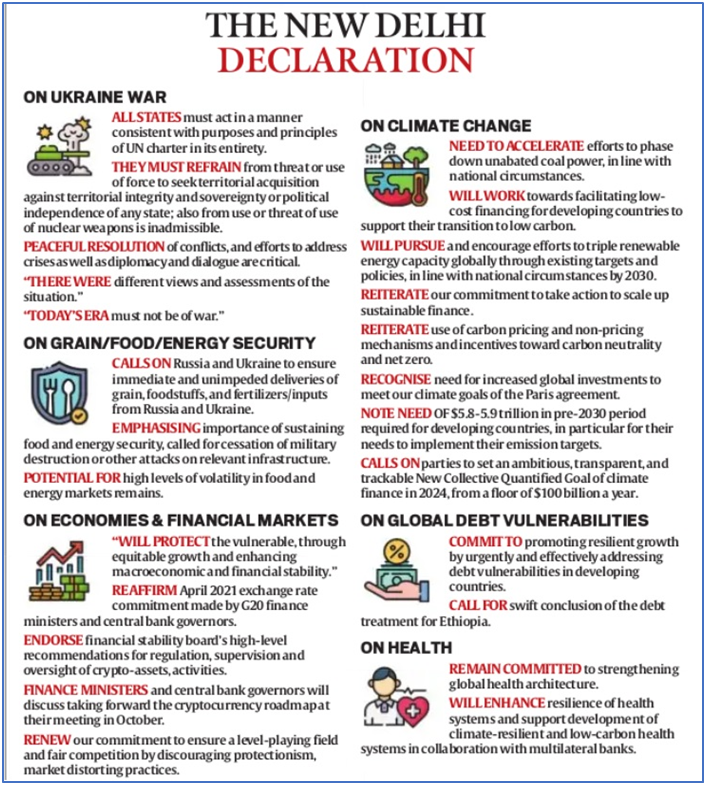Why in news?
- The leaders at India’s G20 Summit 2023 arrived at a joint communique — called the G20 New Delhi Leaders’ Declaration.
- This is a significant victory for India’s G20 presidency that came amid increasing tensions and divergent views over the Ukraine conflict.
What’s in today’s article?
- G20 New Delhi Declaration
G20 New Delhi Declaration: Key highlights

- Uniqueness of the Declaration
- The communique is filled with deliverables on a range of issues. It is also crafted in a different way — not the usual paragraphs that are structured in a joint declaration.
- Instead, it starts with a preamble, and then has 10 chapters, and ends with a conclusion.
- On Ukraine
- The big sticking point was the Ukraine-Russia conflict, which was addressed in detail in seven paragraphs.
- This is much more elaborate than the Bali Declaration, which had just two paragraphs.
- The Russia-Ukraine paragraphs did not condemn Russia for its actions, nor did it call it an aggression. But the West also got what it wanted.
- Strong, Sustainable, Balanced, and Inclusive Growth
- It talks about the global economic situation, advancing financial inclusion, and fighting corruption.
- It vows to implement the Action Plan against Fugitive Economic Offenders that will help strengthen international cooperation and information sharing.
- Accelerating Progress on Sustainable Development Goals (SDGs)
- This is about eliminating hunger and malnutrition, health collaboration and delivering quality education among others.
- One of the important elements is on how future pandemics can impact the economy, which also brings out the gaps in the existing pandemic response mechanism, including institutional and funding arrangements.
- On education, it talks about enhancing teachers’ capacity, improved curricula, content in local language, and access to digital resources.
- This will ensure that all children, including the most marginalised, are provided with the essential building blocks for all future learning.
- Green Development Pact for a Sustainable Future
- It stresses the need to implement clean, sustainable, just, affordable, and inclusive energy transitions.
- One important element is the mention of the need to build reliable, diverse, responsible, and sustainable value chains of critical minerals, semiconductors, and related technologies.
- Multilateral Institutions for the 21st Century
- It speaks of reforming international financial institutions.
- One of the most important elements is that:
- reform of the UN Security Council was agreed to for the first time in the G20; and
- there was a strong push towards reforms for better, bigger, and more effective Multilateral Development Banks (MDBs).
- They also called for managing debt vulnerabilities of low and middle-income countries and the start of exchange of tax-relevant information on crypto assets by 2027.
- Technological Transformation & Digital Public Infrastructure
- This chapter contains elements of building digital public infrastructure, crypto-assets, and harnessing Artificial Intelligence (AI) responsibly.
- On AI, they agreed to pursue a pro-innovation regulatory/governance approach that maximises the benefits and takes into account the risks associated with the use of AI.
- The G20 leaders agreed on a G20 framework for digital public infrastructure and Global Digital Public Infrastructure Repository (GDPIR).
- The framework calls for building interoperable solutions and formulating laws that can ensure that DPIs are safe, secure, trusted, and governed transparently.
- It also talks about a comprehensive toolkit which is aimed at improving cyber education and cyber awareness for the protection and empowerment of children and youth.
- Another key win for the India’s G20 presidency was to gather consensus around creating a global regulatory framework for crypto-assets.
- They endorsed the Financial Stability Board’s (FSB’s) high-level recommendations for the regulation, supervision and oversight of crypto-assets activities.
- Gender Equality and Empowering all Women and Girls
- It promotes equal rights to economic resources, property ownership, financial services, and inheritance for women.
- It also supports women’s organisations and networks, and closing gender gaps in agricultural access.
- Under India’s G20 Presidency, a decision to create a full-fledged working group on women’s empowerment has been made.
- The group will prioritise gender equality, women’s empowerment, and leadership, and bring convergence across sectors at all levels.
- On Countering Terrorism and Money Laundering
- It contains a strong condemnation of terrorism in all its forms and manifestations, and a positive message towards international peace and security.
- Creating a More Inclusive World
- India’s G20 Presidency has paved the way for the African Union’s permanent membership in the G20.
- This will make G20 more inclusive, deepen cooperation with Africa, and help realise its developmental aspirations.
- Also, there is a commitment to promote respect for religious and cultural diversity,
- It deplores all acts of religious hatred, including against religious symbols and holy books.
- From Delhi, a vision for Brazil, South Africa, US
- In conclusion, there were a few broader takeaways that this Summit projected:
- a strong commitment for future Presidencies including for the new cycle beginning in 2026 — Brazil in 2024, South Africa in 2025, and the US in 2026.
- There was recognition of all Engagement Groups and Initiatives of India’s G20 Presidency.
- By conducting over 200 meetings in 60 cities across India, New Delhi has set a new template — and a high bar — of taking G20 to the people.
- The democratisation of diplomacy is a key takeaway from this successful exercise.










